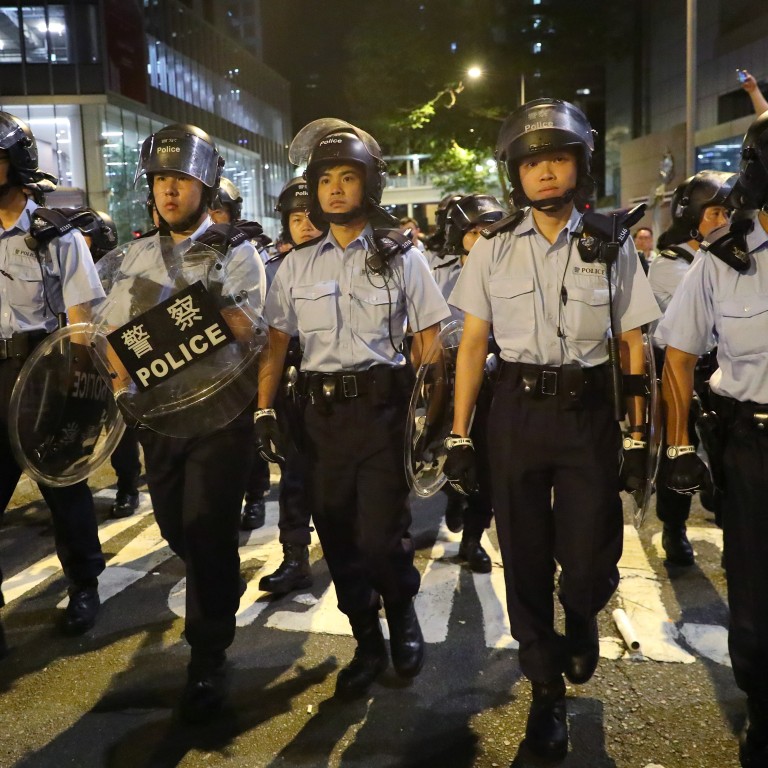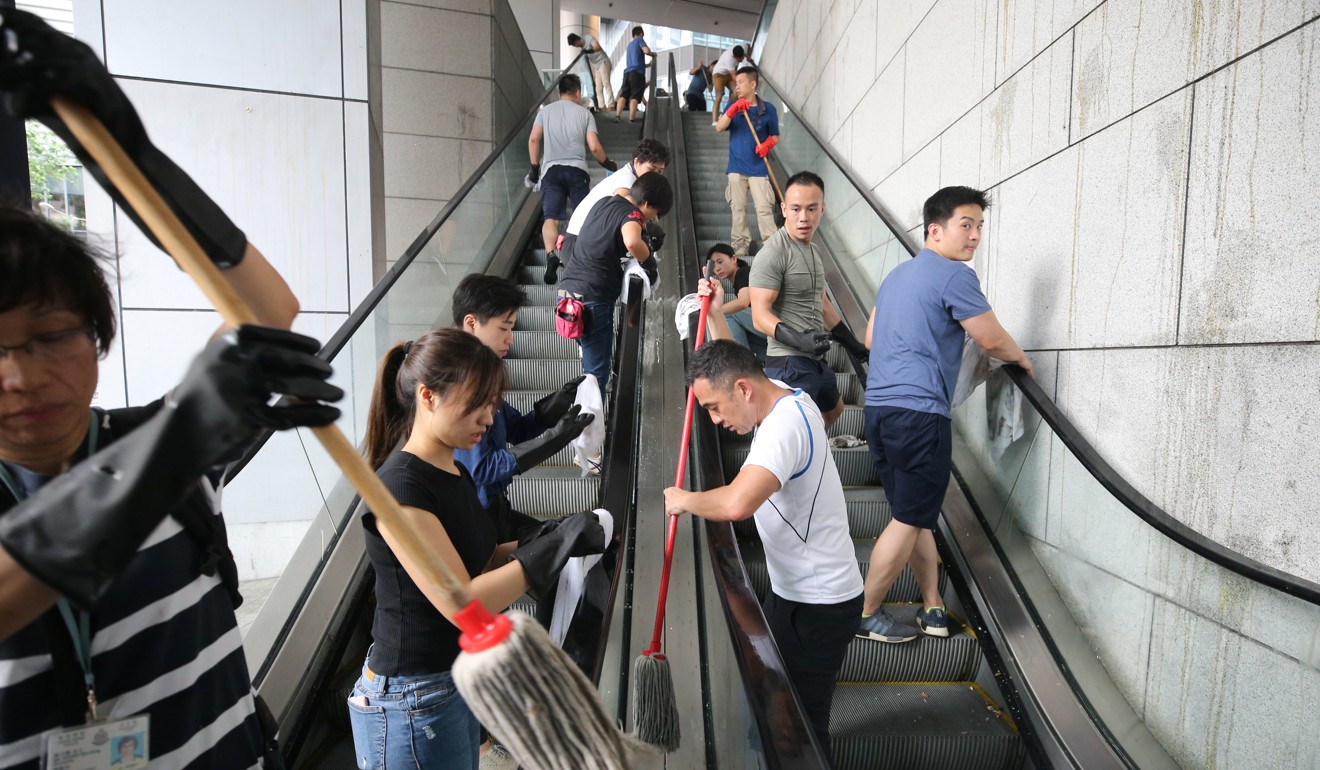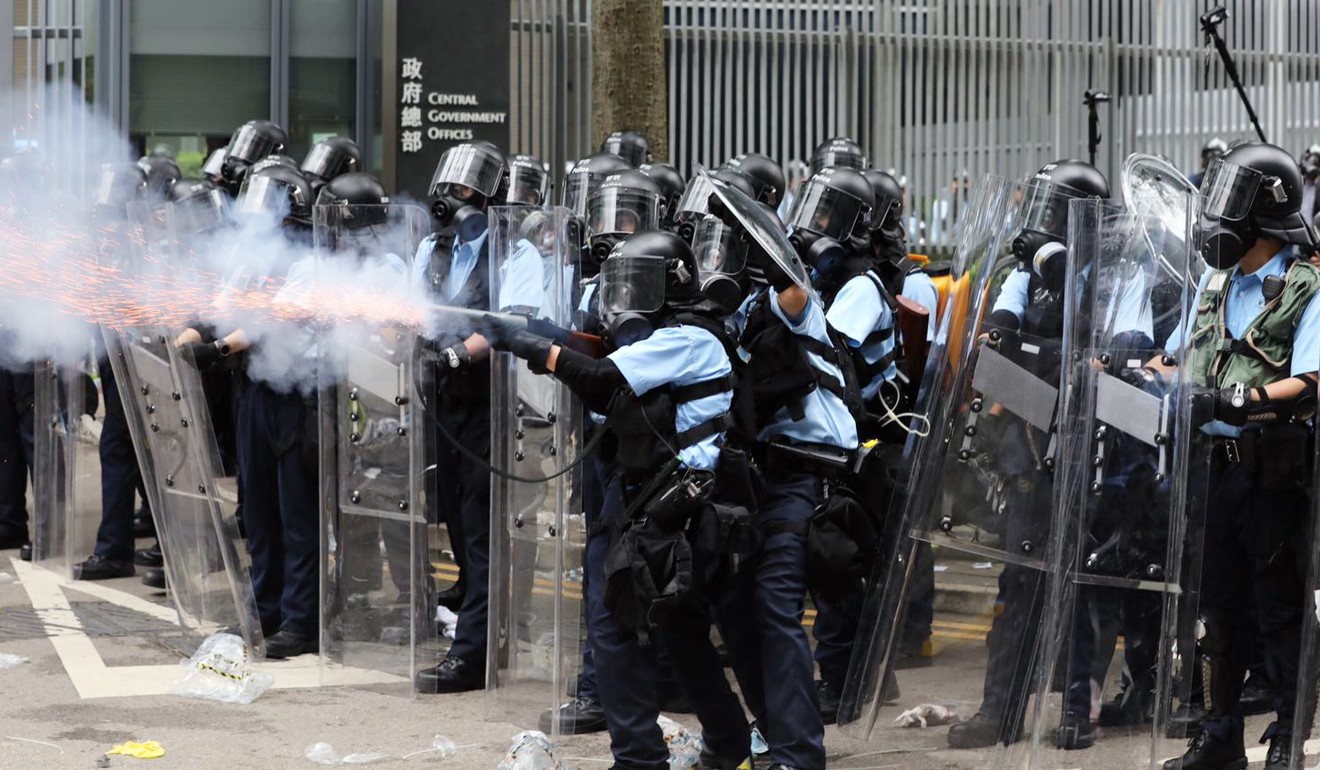
Hong Kong police plan to ‘stick to soft approach and exercise restraint’ after 15-hour siege by protesters against extradition bill
- Muted tactic praised for avoiding clashes but concerns raised over morale of force, as observers note some protesters had clearly broken law with impunity
- Force wary of deepening public mistrust following June 12 crackdown
Hong Kong police plan to stick to their restrained approach towards anti-extradition bill protesters despite a 15-hour siege of the force’s headquarters that ended only early on Saturday morning, the Post has learned.
While the more muted and controlled tactic was praised for successfully avoiding clashes, some observers and officers also raised concerns over morale in the force, pointing out that laws had been broken with impunity while officers stood by watching.
For hours throughout Friday, police were reduced to standing silently behind glass doors and windows as protesters threw eggs at their Wan Chai headquarters, painted graffiti over the building’s walls, blocked the exits of the compound and flashed laser beams at them.

In the aftermath, the force appeared to have taken several measures to bolster spirits, including distributing inspirational videos of colleagues and paying closer attention to the physical needs of employees.
“At this stage, we will continue to remain tolerant until protesters use force to storm police lines and pose a risk to the public,” a source in the force told the Post.
At this stage, we will continue to remain tolerant until protesters use force to storm police lines and pose a risk to the public
Protesters besiege police headquarters into Friday night after day of mobile rallies

This was despite Chief Executive Carrie Lam Cheng Yuet-ngor earlier suspending the divisive proposal, which if passed, would allow the transfer of fugitives to jurisdictions with which the city has no extradition deal, including mainland China.
Lam’s move marked a clear turning point in police strategy as officers reduced their presence and largely stood aside during the June 16 march.
At Friday’s siege, after two apologies from Lam over the mishandling of the bill, police continued with the same approach, ending in protesters finally leaving the force’s headquarters on Arsenal Street in Wan Chai early on Saturday morning. Demonstrators were calling for the full withdrawal of the bill, among other demands.
Police ‘threatened and humiliated’ in backlash to force’s response to protests
“To an extent the new strategy has been successful,” said security consultant and former police superintendent Clement Lai Ka-chi. “The protesters dispersed themselves without any clashes, and the most important thing is that this time, nobody can accuse police of using excessive force.”
This time nobody can accuse police of using excessive force
Lai said the approach showed that the force was willing to adapt to public expectations.
“But the price is that officers have to bear with verbal insults and accusations,” he said. “It will inevitably give rise to divisive opinions within the force.”
The new strategy appeared to be in line with that of the government, as officials remained low over the past week and avoided discussing controversial issues.

The Post was told that while some officers agreed the force should exercise restraint when handling protests, others questioned why no enforcement action was taken when it was already clear some in the crowds had broken the law by defacing walls at the police headquarters and blockading the complex’s exits.
Protesters will be charged, Hong Kong justice minister says
“There is an inevitable impact on morale,” another source said, adding that hundreds of officers and civilians were trapped inside the compound during the siege.
One stranded senior inspector, who is four months pregnant, told reporters that she had to call her mother-in-law urgently to take care of her 14-month-old son at home.

“Our supervisors tried twice to arrange for pregnant colleagues to leave the premises, but we were blocked by protesters at the exit,” she said. “We tried to talk to them but it was no use.”
Shooting at protesters ‘necessary and lawful’, ex-police chief says
Another senior inspector, who has a six-year-old daughter with a rare disease, said: “I’m sad at being unable to take care of my family physically and emotionally.”
In the aftermath of the siege, the stench of raw egg lingered around the headquarters, and officers and cleaners had to clear the barricades, graffiti and stickers left by protesters, as well as fix surveillance cameras that had been taped.
“[The siege] is an illegal assembly,” said Lam Chi-wai, chairman of the Junior Police Officers' Association. “The participants totally ignored people’s safety and engaged in extremely immoral action.”
The participants totally ignored people’s safety and engaged in extremely immoral action
Lam vowed to take his complaint to the force’s most senior ranks and warned protesters, including those who called for internet users to ferret out information on officers involved in the crackdown, that there would be follow-up investigations.
Asked whether police would continue with the soft stance, a force insider said “a reasonable approach will be adopted to deal with peaceful public events”.
He said about 5,000 officers in two 12-hour shifts each day were still on standby to combat possible chaos. More officers would be drafted if necessary.
Be water, my friend: how Bruce Lee has protesters going with flow
To boost morale, the force produced a video in which various senior or frontline officers and backup personnel shared encouraging messages, such as: “Hang in there. Add oil!”
Around 2.30am on Saturday, when protesters were gone from the headquarters, the force arranged coaches to send home staff who had been trapped for hours.
One of the police sources also told the Post that tens of thousands of cup noodles had been stockpiled since the clashes on June 12, along with biscuits and water.
Former police chief Andy Tsang Wai-hung also spoke up for his ex-colleagues on Saturday, saying officers only used force on June 12 to protect the safety of the legislative compound, civilians and themselves after protesters tried to push them back and hurled objects at them.

Officers that day were seen forcibly handling unarmed demonstrators, tackling journalists and later, even arresting protesters in hospitals. But videos also showed people throwing bricks and sharp metal objects at police.
“The Hong Kong Police Force has always been restrained in its use of force,” Tsang said. “The use of force in this incident is indeed rare.”
To reconcile differences with the public in the long run, security consultant Lai said police must review their handling of the issue. Declining to comment on the clashes, he would only say: “There is absolutely room for the force to improve.”


